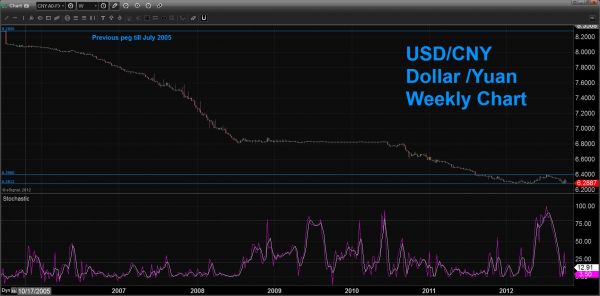Most traders do not follow the Chinese yuan. Several American politicians accuse the Chinese of currency manipulation to make their exports cheaper. Most economists analyze the data out of the two largest economies, U.S. and China. Some trading platforms do not even provide the price feed for the USD/CNY currency pair. There must be a good reason why the yuan does not get more currency coverage.
A LITTLE BACKGROUND
Until July of 2005, the yuan was pegged to the dollar at the 8.28 rate. If a currency pair does not have significant moves, traders will find better opportunities. Earlier this year, China widened the yuan’s trading band to the U.S. to 1.0% from 0.5% and pledged to keep loosening controls till 2015. This was considered a step in the right direction for having a free floating, convertible currency. This week, price action reached the .98% of the band and made a new record high for the yuan at 6.2812.
Over the last few years, the Peoples Republic of China has played the political game beautifully against the rest of the world. Throughout the financial crisis, China was growing around 10.0%, while several advanced economies were in recession. They allowed their currency to appreciate to ease the attacks of currency manipulation, but more importantly to increase the purchasing power of their countrymen.
GROWTH NEWS
The International Monetary Fund (IMF) downgraded the growth forecast around the world in its World Economic Outlook. The 2012 global growth outlook decreased to 3.3% from 3.5% and 3.6% verse 3.9% in 2013. The overall tone was gloomy for the advanced economies. Surprisingly, the report also expects the U.S. to avoid the fiscal cliff.
EXPORTS WERE KEY FACTOR
The report attributed China’s decrease in growth to a decline in exports. China’s forecast for 2012 GDP is at 7.8%, well off the 9.2% achieved in 2011 and the 10.4% in 2010. Credit condition will probably remain tight with concerns of a potential real estate bubble. With increasing concerns of slower growth coming out of China, monetary authorities might weaken the yen a little bit before allowing it to strengthen again.

THE CHART
The weekly chart below displays a significant downward trend that made a new record low and penetrated key support near the 6.2840 area. Normally, we would ride the trend and target new record levels, but with the yuan, we exercise a different playbook. Since the Chinese Government weakened the yuan after hitting these levels, it should not come as a surprise if we see yuan weakness over the next couple of weeks. We will look for a retest of the 6.3960 level and place a stop just below the new record low price of 6.2810
= = =




